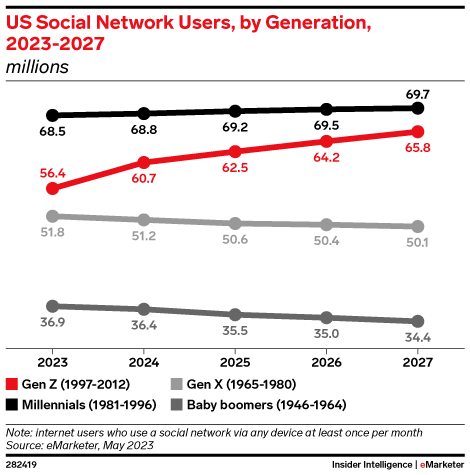From its early origins of being Facebook, Meta has come a long way. Here’s a quick overview of Meta advertising.
Meta has been at the top of the social media scene since Facebook’s breakout launch in the early 2000s. Facebook cleverly rebranded as Meta several years ago to better integrate its acquisition of Instagram. Since then, the company has continued to grow and shift, changing to match user behavior and capture attention. Meta’s social media portfolio now consists of Facebook, Instagram, Threads, and WhatsApp.
In the company’s decades-long rule as the largest social media company, it has established itself as a major player in the advertising space. Facebook and Instagram ads (as well as the sure-to-come Threads ads) are a critical tool in many marketers’ playbooks.
Meta ended 2023 with strong user growth, in large part due to the momentum they’ve built with Instagram Reels. On all of the company’s platforms, it has a total of 3.88 billion worldwide active users. The company may even reach the 4 billion mark in 2024. This growing user base has led to an 11% increase in ad revenues worldwide in 2023’s second quarter. Not only that but on Facebook alone, the average revenue per user is predicted to rise by 10.6% in 2024.
Millennials and Generation Z are the most prominent demographics to use Meta’s platforms, with millennials having previously been dubbed “the Facebook generation.” Millennial users make up 30% of total social media users in the US, with GenZ making up another 24.7%. This is a total of 124.9 million users in the US alone. And this number is growing.

Now, with the introduction of Threads, Meta is looking to corner another aspect of the social media market. This social media giant is a survivor. No matter the shift in online behavior, the company has shown its adaptability. Its consistent stream of users and enthusiasm for new techniques and technologies makes the company’s many apps and networks effective advertising platforms. Meta’s growth also underlines the importance of understanding how to use advertising tools and techniques on Meta.
How do Meta ads work?
At its core, Meta ads are those that are served to users based on their previous interactions and behaviors online. They leverage data collected about individuals’ browsing habits, search history, and other online activities to deliver ads that are highly relevant and personalized.
Cookies
One of the key components of Meta ads is the use of cookies to collect user data, like which websites they visit and products they browse.
This data is then used to create a comprehensive profile of the user, including their interests, preferences, and demographics. Advertisers can then use this information to target specific groups of users who are most likely to be interested in their products or services.
Marketers should, however, be careful not to rely on third-party cookies, since within the next few years, they’ll be entirely eliminated. Google will be phasing out third-party cookies completely sometime in 2025. For marketers looking for more information on cookieless marketing, our cookieless guide takes a deep dive into what the future of targeting will look like.

Algorithms and machine learning
Meta ads also utilize advanced algorithms and machine learning to analyze and interpret collected data. These algorithms are constantly improving and evolving, allowing advertisers to deliver highly targeted ad campaigns that generate better results.
Targeting its vast user base of over 3.88 billion monthly active users, Meta understands the importance of delivering personalized and targeted ads. By leveraging its extensive data, Meta aims to connect advertisers with their desired target audience and reach potential customers more effectively.
Ad formats and placements
Meta ads also offer various ad formats and placement options. Ads can be displayed on social media platforms, search engines, mobile apps, and websites, ensuring maximum reach and visibility.
In its latest move to enhance its advertising capabilities, Meta announced plans to put new ads on Facebook and Instagram user profiles. This strategic expansion aims to provide advertisers with increased visibility and access to a wider audience, while also ensuring a seamless user experience.
Retargeting
Another important feature of Meta ads is retargeting. This strategy involves showing ads to users who have previously interacted with a brand or visited their website. By reminding these users of their previous interests, retargeting aims to bring them back into the sales funnel and increase the chances of conversion.
To ensure the success of Meta ads, advertisers have access to a range of tools and metrics to track and optimize their campaigns. They can monitor the performance of their ads in real-time, analyze metrics such as click-through rates and conversions, and make data-driven decisions to improve their advertising strategies.
Best practices for Meta advertising
In the ever-evolving advertising landscape, staying ahead is crucial for businesses that want to maximize their reach and impact. Still, Meta’s numerous capabilities and benefits must be used ethically and responsibly. Advertisers must prioritize user privacy and comply with regulations to avoid any discriminatory content or misuse of personal data.
Here are some best practices to help you navigate the world of Meta advertising:
Understand target audiences
Defining your target audience is the foundation of any successful advertising campaign. With Meta’s advanced capabilities, such as detailed targeting and lookalike audiences, you can precisely reach potential customers who are most likely to be interested in your products or services. Take advantage of the range of demographic and interest-based filters available to create highly targeted campaigns that resonate with your target audience.
Use multiple placements
Meta offers a wide array of advertising placements, including Facebook stories, Instagram reels, and audience networks. Consider utilizing multiple placements within a single advertising campaign to maximize your exposure and reach. By diversifying your placements, you can tap into different audiences and platforms to increase your chances of connecting with potential customers.
Optimize ads for mobile devices
In today’s mobile-first world, optimizing your campaigns for mobile devices is crucial. With increasing users accessing social media platforms like Meta through their smartphones, it’s essential to ensure your ads are responsive, visually appealing, and user-friendly on mobile devices. Test different ad formats and creatives to determine what works best for mobile users and tailor your campaigns accordingly.
Implement retargeting strategies
Retargeting campaigns on Meta can be highly effective in converting potential customers into buyers. With dynamic product ads and the ability to retarget specific audiences based on their actions, such as video views or interactions with your website, you can remind potential customers about your products or services and encourage them to take action. Leverage the power of retargeting to stay top of mind and increase the chances of conversion.
Monitor and optimize campaign performance
Advertising on Meta is not a one-time setup. It requires regular monitoring and optimization to ensure optimal performance. Keep a close eye on key metrics like ad engagement, click-through rates, and conversions. Use A/B testing to experiment with different ad formats, messaging, and targeting options. By continuously analyzing the performance of your campaigns, you can make data-driven decisions and refine your strategies to achieve better results over time.
Make use of automation tools
Meta has a set of automation tools (Advantage + suite) that can be used for the best advertising results. Meta’s AI systems allow advertisers to target ads based on user responses and trends identified through an algorithm. Advertisers have seen improved responses while using Meta’s automation tools. Different iterations of the same messaging also play a vital role in delivering relevant messages to specific audiences.
Choose conversion tools
Meta has rolled out its Conversions API to create a direct connection between marketing data and their platform to improve campaign performance and measurement. Conversion API bridges data in Meta’s system with accounts that complete an action. Complimenting the API is Conversion Lift to measure ad performance. Conversion Lift can help advertisers measure the impact of ads, quantify the value of marketing mix modelling, and use A/B testing to compare different strategies.
Final thoughts
As Meta continues to innovate and adapt to the evolving digital landscape, businesses can look forward to new opportunities to showcase their products and services. With ads popping up across Facebook and Instagram, including on user profiles, Meta is opening up new avenues for advertisers to engage with their customers and capture their attention in unprecedented ways.
To see more from illumin, be sure to follow us on Twitter and LinkedIn where we share interesting news and insights from the worlds of ad tech and advertising.












